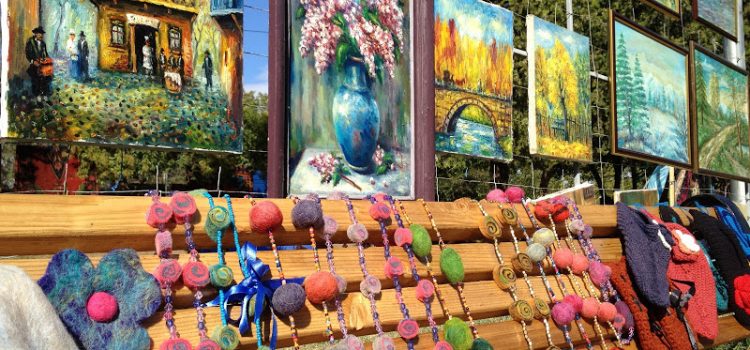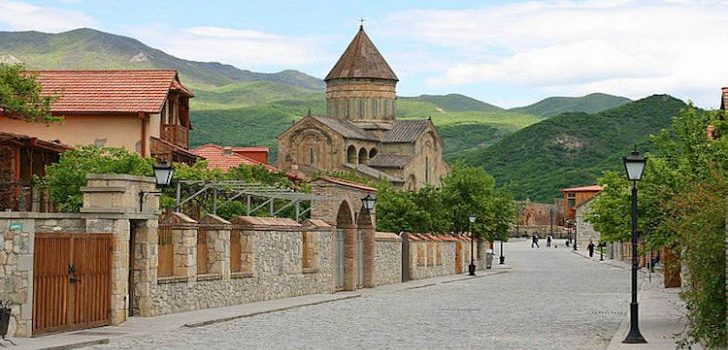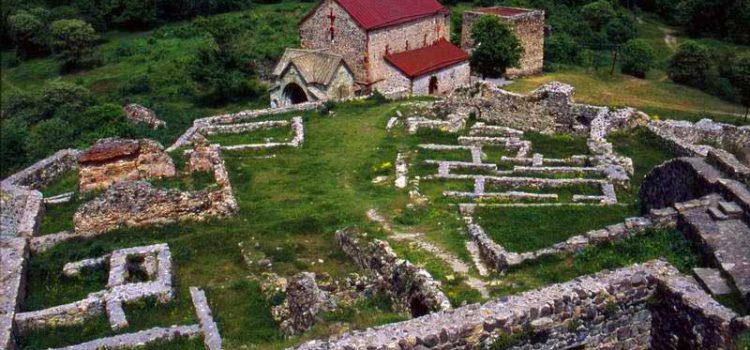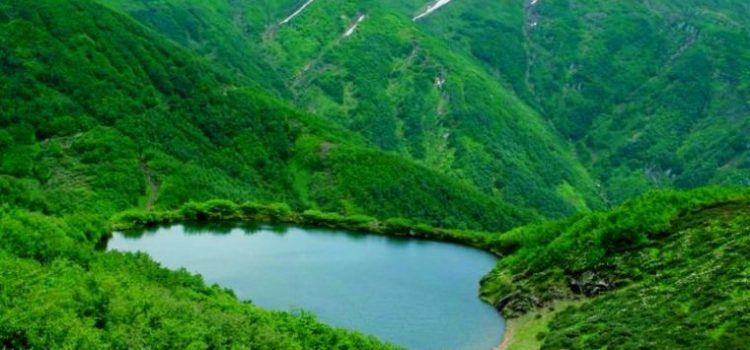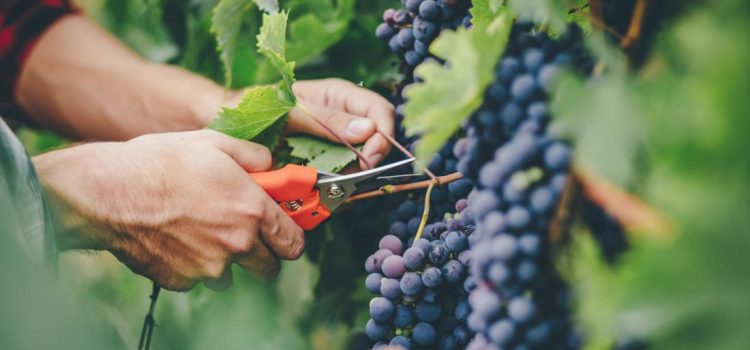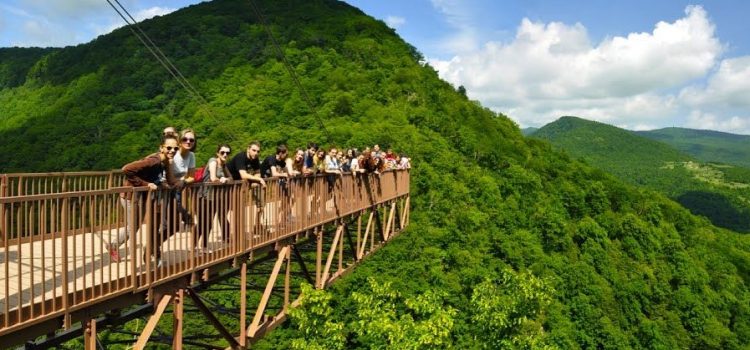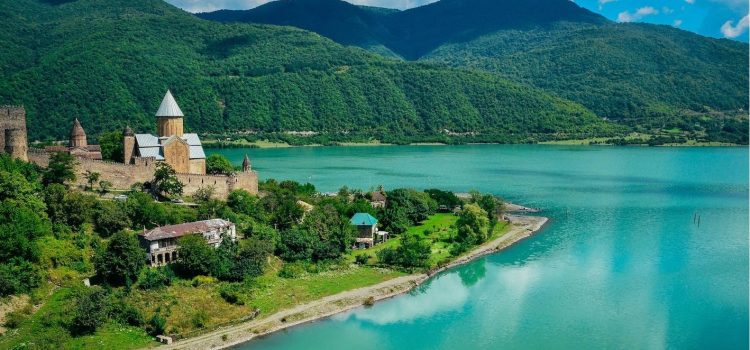Dry Bridge Flea Market – Best Place For Unique Souvenir Shopping In Tbilisi
Located in Tbilisi’s historic old town, 20 minutes walk from Freedom Square, Dry Market is the place, where you can buy literally every souvenir you ever dreamed of.
Even more, alongside traditional, typical tourist trinkets you can encounter old military medals from WWII, old enamel, Soviet kitsch, handmade jewelry (sometimes very eye-catching and exquisite pieces), vintage cameras and many other stuff without much fuss.
Here You can find original eastern European, Soviet, Georgian and even Armenian or Azerbaijani souvenirs.
Many pins and badges are waiting for you to choose and take home.
There are many oil paintings and watercolors, usually full of amazing, bright colors and cheerful spirit.
You may spend several hours just wandering and exploring from one to another, because you will never know, what another surprise is waiting for you at the next one.
You can see old Samovars, cameras, books, family photos, postcards, eyeglasses, playing cards and many other.
Also, there are sometimes absolutely unexpected things.
So, next time in Tbilisi, you know where to go for shopping
Source: Georgia.travel; Megapass
Heritage Sites
Heritage Site
Cave Towns Among the few notable cave towns in the world, the Georgian ones are of very special interest. Uplistsikhe, David Gareji monastery, and the world-famous cave town of Vardzia are nominated for the UNESCO World Heritage list. Uplistsikhe, ‘the fortress of the Lord’, can be dated back to the early Iron Age, and is located on a high rocky escarpment overlooking the bank of the Mtkvari River. Cut from natural sandy stone, the 8 hectares of cave-town have survived millions of people, erosion, aging and even earthquakes, but it still remains a good example of the mixture of pagan & Christian architecture. David Gareji monastery was founded in the 6th century on the slopes of the Gareji hills by one of the thirteen Syrian Fathers, Father David (Garejeli). Those fathers were missionaries from Mesopotamia promoting and spreading Christianity, the respected founders of many monasteries and holy places around Georgia. The frescoes here are superb. Some of them date as far back as the 9th and 10th centuries. The Golden Age of Georgia is directly reflected in the incredible 11th – 13th century frescoes. The incredible cave town of Vardzia dates back to Queen Tamar’s reign, nearly a thousand years ago. Her father, King George III started the foundation of the complex, while Queen Tamar continued its construction. Many frescoes date back to the beginning of the XII century. The complex itself consists of small chapels, bell towers, secret tunnels, monks’ caves as well as a fully functioning monastery to this day. Set in the most serene and stunning countryside, its beautiful location captures your imagination and brings you back to the era of Queen Tamar’s reign. Bagrati Cathedral and Gelati Monastery(UNESCO WEB) The construction of Bagrati Cathedral, named after Bagrat III, the first king of united Georgia, started at the end of the 10th century and was completed in the early years of the 11th century. Although partly destroyed by the Turks in 1691, its ruins still lie in the centre of Kutaisi. The Gelati Monastery, whose main buildings were erected between the 12th and 17th centuries, is a well-preserved complex, with wonderful mosaics and wall paintings. The cathedral and monastery represent the flowering of medieval architecture in Georgia. Historical Monuments of Mtskheta(UNESCO WEB) The historic churches of Mtskheta, former capital of Georgia, are outstanding examples of medieval religious architecture in the Caucasus. They show the high artistic and cultural level attained by this ancient kingdom. Upper Svaneti(UNESCO WEB) Preserved by its long isolation, the Upper Svaneti region of the Caucasus is an exceptional example of mountain scenery with medieval-type villages and tower-houses. The village of Chazhashi still has more than 200 of these very unusual houses, which were used both as dwellings and as defence posts against the invaders who plagued the region.
Meet your hominid ancestors in Georgia
Over 500 Paleolithic sites have been discovered in Georgia, which is considered a crossroad of cultures due to its location in the South Caucusus. Dmanisi, southeast of the capital Tbilisi, is considered one of the most significant sites.
“Exactly twenty five years ago we found a human jaw in Dmanisi – this was big sensation. It was impossible to imagine that you could have 1.8 million year-old fossils out of Africa. Since this discovery we have discovered another fossil. Now we have five skulls, four with jaws, different anatomical elements as well as animal bones and stone tools. Now, we could say that we have the best collection in the world of the early Homo out of Africa,” explains David Lordkipanidze, general director of the Georgian National Museum,
The Dmanisi skull is the most complete ancient hominid skull found to date. Known as Skull 5, it was discovered alongside the remains of four other early human ancestors, animal fossils and stone tools – all believed to be from the same time period – which makes the find truly unique.
“It’s the first evidence of humans moving out of Africa – very simple stone tools, brains literally a third of size of modern humans, but nonetheless they were able to exist in an environment with large saber-tooth cats and hyenas and other dangerous animals. It’s quite incredible,” says Nicholas Toth, co-director of the Stone Age Institute in Indiana.
The finding has forced scientists to rethink the story of early human evolution, as it could mean that rather than several Homo species, only a single-species – able to cope with a variety of ecosystems – emerged from the African continent.
‘Stone Age Georgia’ runs at the Georgian National Museum until September 2017.
Source: Euronews.com
Mtirala: Georgian nature at its purest
It is pure, unblemished nature…
Yet the Mtirala National Park can be found just 40 kilometres from Batumi, the capital city of Georgia’s autonomous republic of Adjara.
“We’re lucky to have the sunshine: this Adjarian national park, Mtirala, is considered Georgia’s rainiest spot of land,” said Euronews reporter Denis Loctier, as he explored the region.
In this high humidity, the air is fresh and fragrant with blooming flowers and herbs.
It’s a protected site for the region’s flora and fauna, including rare and endangered endemic species.
“Mtirala translates as ‘a weeping mountain’. This place is often clouded in mist and drizzle. That’s where the name comes from,” explained park guide, Zia Kontselidze.
At 1,500 metres above sea level, Mtirala’s trails are perfect for hiking, bird watching and adventure tours.
Source: Euronews.com
Vardzia: ‘The Cave Town’
It is called the cave town.
Vardzia is a spectacular site in southern Georgia, dug out of the Erusheti Mountain in 1185.
It had special significance for Georgians because it was associated with King Tamar – such a charismatic woman that she was crowned King instead of Queen!
“Among all the architectural jewels of Georgia, the Vardzia complex is the most precious,” said ‘Postcards’ reporter Claudio Rosmino.
“In this city, carved into the rock, there were houses, shops, libraries and even a water network. In total, 6,000 rooms, spread out over 13 levels”
In 1283, just a century after its construction, a devastating earthquake destroyed a huge part of the site. What we see today is less than a third of its original size.
“Vardzia cave complex was built for approximately 48 years by hand and was designed to host 50,000 people for defence purposes,” explained museum guide Tina Zedginidze.
“But later it became a Royal monastery with educational functions”
A small group of monks is still living there. Some 300 apartments can be visited and in some tunnels the old irrigation pipes still bring drinkable water.
Source: Euronews.com
Evidence of ancient wine found in Georgia a vintage quaffed some 6,000 years BC
Archaeologists are hard at work sifting through the dirt at a dig in Imiri, south-eastern Georgia.
The scientists believe that the site contains artefacts that could once and for all prove that Georgia is the oldest wine producing country in the world.
Eight thousand years ago, during the neolithic era, farming and agriculture were flourishing in the three villages that now make up the Shulaveri – Shumitepe Cultural ruins in Marneuli Valley.
And one of the products being grown and harvested proved to be grapes to make wine.
Stephen Batiuk is from the University of Toronto: “What is significant about this site is that it produced some of the earliest examples of domesticated grapes, which we believe were involved in the earliest production of wine. We know that a wine vessel was discovered in Shulaveri, which also provides evidence of early wine production. But here (Imiri site) wine could be produced even earlier taking wine production in Georgia all the way back to 6,000 BC.”
David Lordkipanidze, is director of Georgia’s National Museum:
“The aim of this project is to look at the history of agriculture. It’s not just only the question of the earliest wine and we have found here traces of very old wine making, but as well to look at the domestication of the weeds, of the different agricultural products, which shows that Caucasus and Georgia were part of this big geographical territory, the so called Fertile Crescent, where the earliest agriculture was appearing and first civilisations were spreading.”
The Fertile Crescent is a swathe of land stretching from upper Egypt to Mesopotamia, modern day Iraq, Kuwait and northeast Syria.
Source: Euronews.com
Tourists speak about Georgian wine at the Georgian Wine Festival 2018
Georgian Wine Festival 2018 has been going on for several hours already on the Shardeni Street in Tbilisi. Locals and tourists attend the event and are tasting products represented there.
What tourists say about Georgia
Tourists say that Georgian wine is distinguished with its diverse taste and is one of the best gifts they will take to their countries.
“I guess it is a wine holiday. I like Georgian wine very much and due to diverse taste of it, anyone can find their favourite wine. My favourite wine is Kindzmarauli. I have tried Kisi for the first time here and enjoyed it very much. All of my friends in Russia wait that I will take there a bottle of wine on the way back. I think wine is the best Georgian gift” – says one of the Russian tourists Irina Slavyeva.
“I knew Wine Festival would be hold here so I arrived with my friends and all of us are very satisfied. I have tried different types of wine, but enjoyed Mtsvane Manavi by Batono Company very much. Generally, wines represented at the festival are very tasty. Ensembles sing perfectly well. We are staying here for the whole day and let’s see what else will be performed. Such festivals are very pleasant to the locals” – says Violeta Sharvashidze.
Actors from the Motion Theatre hold costume performance at the moment.
Media supporters of the event are TV PalitraNews, Palitra Radio, ambebi.ge, events.ambebi.ge, ipn.ge, kvirispalitra, georgianjournal.ge, allnews.ge, reitingi.ge.
Georgian Adventures: Okatse Canyon
Georgian adventures continue at the Okatse Canyon near the village of Gordi in the country’s west.
“This area close to Kutaisi is famous for its deep canyons, forest lakes and other fascinating natural attractions,” said Euronews reporter Denis Loctier, trying out a new footpath with vertiginous views.
The 800 metre footpath is visited by 150,000 tourists a year and there are plans to boost the experience further by making its floor transparent!
“The thrill of walking over the canyon attracts many visitors,” Okatse Canyon Director Zaza Gagua told us.
“This is the only place in Georgia where you can really feel this, so it’s not often that people are so frightened that they turn back!”
And if you’re a true adrenaline junkie, you can test yourself by rappelling down Kinchkha, one of Georgia’s tallest waterfalls, with its refreshing cascade of clear mountain water.
source: Euronews.com
10 Reasons why you should visit Georgia
Cradle of Wine – It has been archaeologically proven that the roots of Georgian viticulture are between 9000 and 7000 BC.
A unique Alphabet – There are just 14 independent alphabets in the world and Georgian is one of them.
UNESCO heritage sites – Our current UNESCO heritage sites include the ancient capital city of Mtskheta, the massive cathedral complexes of Bagrati and Gelati, and the mountain region of Svaneti.
Europe’s highest settlement in Georgia – Ushguli is recognized as the highest settlement in Europe, set the altitudes between 2086 and 2200 meters above sea level.
First European civilization – Recent excavations of Dmanisi have revealed and extraordinary record of the earliest homonid dispersal beyond Africa (1,75 million years ago)
Flora and Fauna – Georgia is one of the most ecologically diverse countries in the world, with climatic zones ranging from subtropical to high alpine to semi- desert. Bears, lynxes and even leopards can be found in Georgia’s dense forests of Caucasian fir-the tallest trees in Europe.
Endless tourism possibilities – From adventure tourism to discovering the art of wine making, Georgia has something to delight every visitor.
Summer sea and winter ski resorts – In Georgia, you can swim in the sea as late as November. After that, why not head to the mountains, where there is guaranteed snow until late April, making Georgia a top destination for skiers and snowboarders.
Mountains and trekking – Access to peaks like Mount Shkhara (5201 Meters) and mount Ushba (4710 meters) and opportunities to stay with Svan families in villages make trekking in this region an outdoor and cultural adventure.
Rapid development – The New York Times ranked Georgia 6-th among 52 best countries for the tourism destination. Tbilisi has become one of the safest capitals in the Western World comparable to Lisbon or Vienna.
Georgian Adventures: Pedal power in Batumi
n this episode of Georgian adventures, we jump on one of the hire bikes in Batumi, the booming capital of the Autonomous Republic of Adjara.
“Batumi is one of Georgia’s largest cities and its best known Black Sea resort,” said our reporter Denis Loctier as he peddled along the promenade.
“This coastline boulevard is Batumi’s most famous attraction!”
What originated in the late 19th century as a seaside boardwalk is now a lush seven-kilometre park promenade with dancing fountains, modern sculptures, beach bars and cafés. It is a great place for a leisurely stroll and, even better, for a scenic two-wheel ride.
Pedal-friendly whatever the weather, Batumi is stunning for bike-lovers when the sun shines!
“A bicycle is a very convenient way to see the main attractions of Batumi,” said local student and cycling enthusiast Maia Japaridze.
“It’s not a very big city. You could walk across it in a day and if you get a bike you can get around Batumi very quickly.”
The city is lined with bicycle lanes, offering picturesque views and a refreshing breeze to those who prefer their seaside vacation in the saddle!
Source: Euronews.com

